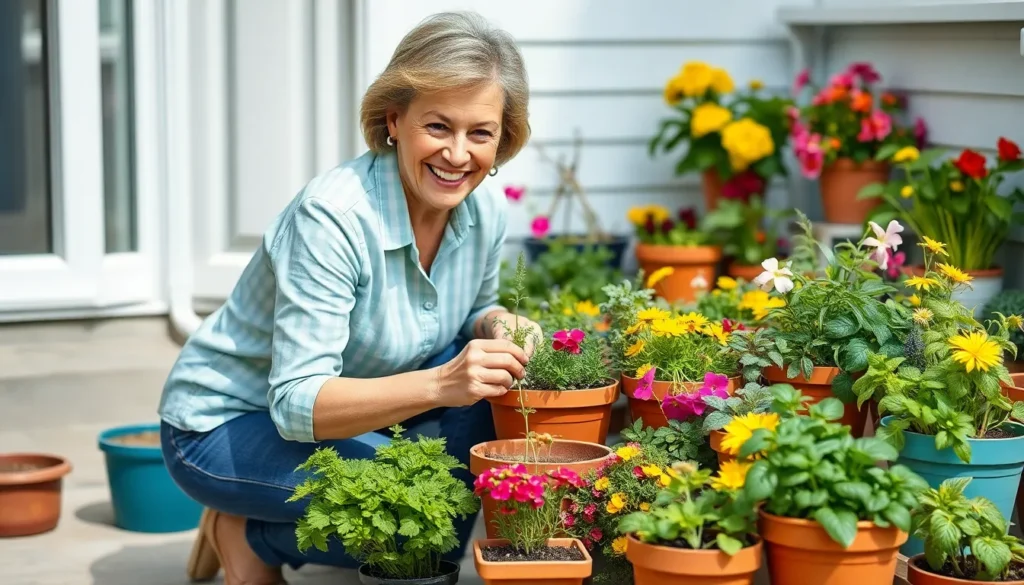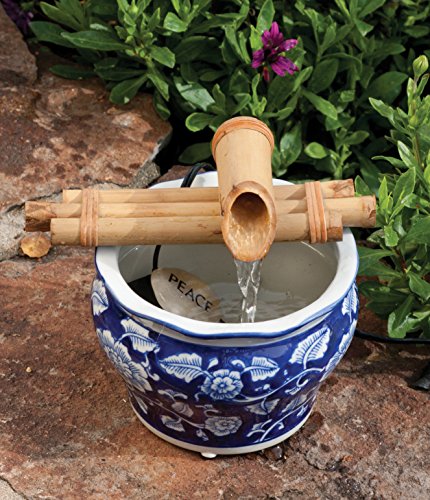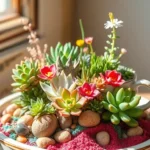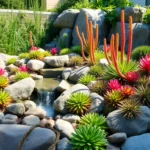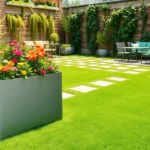We’ve all dreamed of having a lush garden but thought we lacked the space or expertise to make it happen. Container gardening changes everything – it’s the perfect solution for apartment dwellers, busy homeowners, and anyone who wants to grow beautiful plants without the commitment of traditional gardening.
Whether you’re working with a tiny balcony, a concrete patio, or just want to add some greenery to your indoor spaces, container gardens offer endless possibilities. We can grow everything from vibrant flowers and fresh herbs to vegetables and even small trees in pots, planters, and creative containers.
The best part? Container gardening is incredibly forgiving and flexible. We can easily move plants around to catch the perfect sunlight, experiment with different arrangements, and even bring tender plants indoors when the weather turns cold. Let’s explore some inspiring container garden ideas that’ll transform any space into your personal green oasis.
Choose the Right Containers for Your Garden Style
Selecting the perfect containers transforms your garden from ordinary to extraordinary. We’ll explore essential factors that ensure your plants thrive while complementing your unique aesthetic preferences.
Size and Drainage Requirements
Large containers provide the foundation for healthy root systems and sustained plant growth. We recommend choosing pots at least 12 inches deep for most vegetables and herbs, while flowers typically need 6-8 inches minimum. Root vegetables like carrots require containers 10-12 inches deep, and tomatoes thrive in 20-gallon containers or larger.
Drainage holes prevent waterlogged soil that kills plants through root rot. Every container needs multiple holes in the bottom, spaced 2-3 inches apart for optimal water flow. We suggest drilling additional holes if your chosen container lacks adequate drainage, using a drill bit appropriate for the material.
Width matters as much as depth for plant health and stability. Containers should be at least as wide as they are tall to prevent top-heavy plants from tipping over. We’ve found that 14-16 inch diameter pots work perfectly for most herb gardens, while larger vegetables need 18-24 inch containers.
Material Options and Durability
Ceramic and terracotta containers offer classic beauty with excellent breathability for plant roots. These materials naturally wick moisture away from soil, preventing overwatering issues common with plastic pots. We love how terracotta develops a weathered patina over time, though it requires protection from freezing temperatures.
Plastic containers deliver lightweight convenience and weather resistance at affordable prices. Modern plastic options mimic stone, wood, and ceramic appearances while weighing significantly less for easy repositioning. We recommend UV-resistant plastic to prevent cracking and fading in direct sunlight.
Metal containers create striking contemporary displays but require careful temperature management. Galvanized steel, copper, and aluminum resist rust while adding industrial charm to modern gardens. We suggest using plastic liner inserts to protect plant roots from temperature extremes that metal conducts.
Wood containers blend naturally with garden settings and provide excellent insulation for roots. Cedar and redwood resist decay naturally, while treated pine offers budget-friendly durability. We recommend applying food-safe sealers to extend lifespan and prevent soil contact with treated lumber.
Budget-Friendly Container Alternatives
Repurposed household items create unique planters while reducing waste and expenses. Old colanders make excellent hanging herb gardens with built-in drainage, while large yogurt containers work perfectly for seed starting. We’ve transformed everything from rain boots to kitchen pots into charming container gardens.
Thrift store finds offer character and savings for creative gardeners. Vintage watering cans, metal buckets, and ceramic bowls become conversation-starting planters with simple drainage hole additions. We regularly discover unique containers at garage sales and flea markets for under $5 each.
DIY concrete containers provide custom sizing and professional appearance at minimal cost. Mixing concrete with peat moss creates lightweight hypertufa planters that develop natural moss growth over time. We estimate materials cost under $10 for containers that would retail for $50 or more.
Food-grade buckets and storage bins maximize growing space on tight budgets. Five-gallon buckets cost $3-5 each and accommodate large plants like tomatoes or squash with proper drainage modifications. We recommend painting light colors to reflect heat and prevent root damage from temperature spikes.
Create Stunning Herb Container Gardens
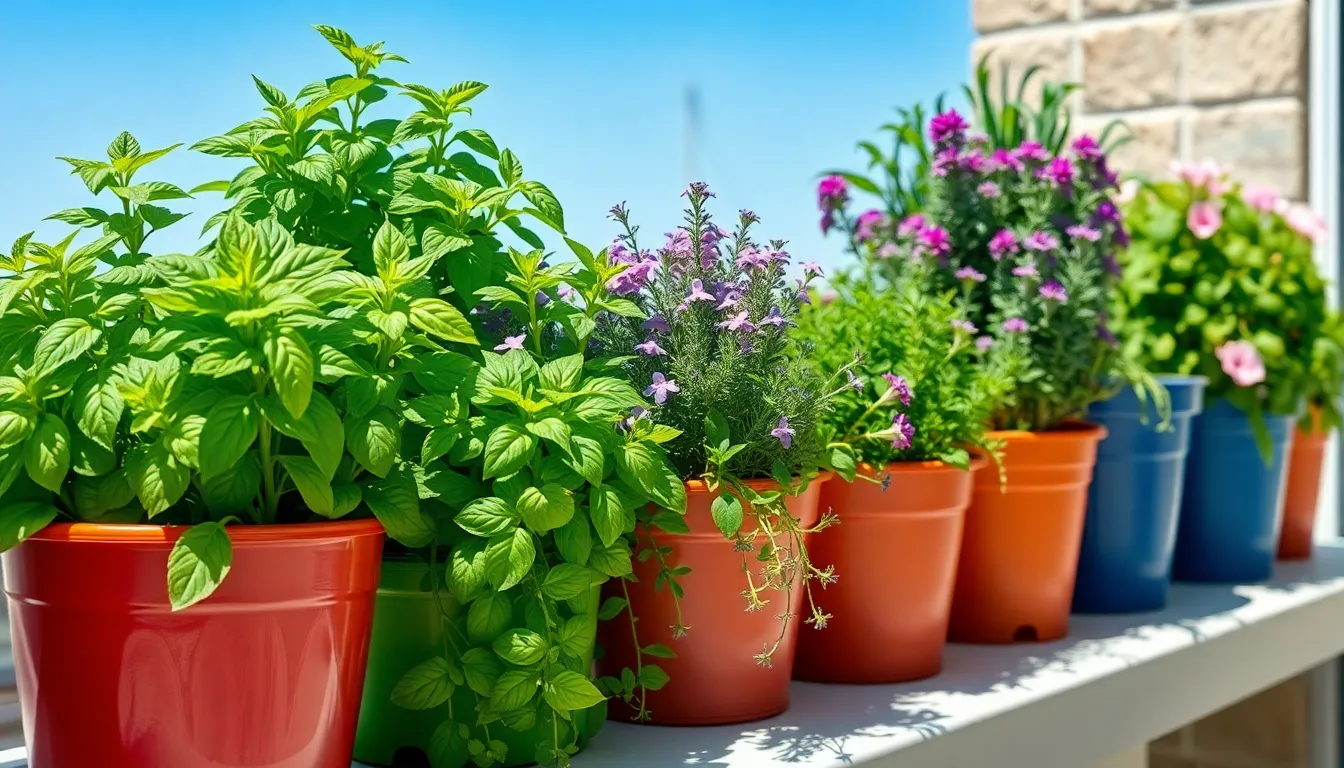
Building on your container selection, herb gardens offer the perfect introduction to growing fresh ingredients right at your fingertips. These aromatic plants thrive in containers and transform any small space into a productive culinary paradise.
Essential Culinary Herbs for Small Spaces
Basil stands as our top recommendation for container herb gardens, requiring just 6-8 inches of depth while providing abundant harvests for pesto, Italian dishes, and fresh garnishes. This warm-season favorite grows rapidly and produces fragrant leaves that enhance countless recipes.
Mint varieties flourish in containers where their spreading nature stays controlled, making them perfect for brewing teas, crafting cocktails, and adding fresh flavor to desserts. We recommend keeping mint in separate containers since it can overwhelm neighboring plants.
Rosemary brings year-round greenery to your container garden while offering woody stems perfect for roasted meats and vegetables. This Mediterranean herb tolerates dry conditions and provides continuous harvests throughout multiple seasons.
Chives deliver a mild onion flavor in compact clumps that fit easily into smaller containers, producing edible purple flowers that add color to both your garden and dinner plate. Their grass-like appearance makes them excellent border plants in mixed containers.
Companion Planting Strategies
Pairing basil with tomatoes creates one of nature’s most beneficial partnerships, as basil naturally repels pests that commonly target tomato plants while both thrive in similar growing conditions. Position these companions in larger containers with at least 18-inch spacing between plants.
Combining fast-growing herbs with slower varieties maximizes your container space efficiently, allowing quick producers like mint to fill gaps while rosemary and thyme establish their root systems. This strategy ensures continuous harvests throughout the growing season.
Grouping herbs by water requirements prevents over or under watering issues, with Mediterranean herbs like rosemary and thyme preferring drier conditions while basil and mint need consistent moisture. We organize our containers based on these watering needs for easier maintenance.
Year-Round Herb Growing Tips
Timing your plantings according to seasonal preferences extends your growing season significantly, with cool-season herbs like mint and chives planted in spring or fall when temperatures range between 50-70°F. Warm-season varieties like basil require soil temperatures above 60°F for optimal growth.
Indoor growing techniques keep herb production going through winter months, using containers near south-facing windows or under grow lights to maintain 6-8 hours of daily light exposure. We move tender herbs indoors before first frost to continue harvesting fresh ingredients year-round.
Regular pruning practices encourage bushy growth and prevent premature flowering, which can make leaves bitter and reduce overall plant productivity. Pinching flower buds as they appear redirects energy into leaf production, giving you more flavorful harvests throughout the season.
Design Beautiful Flower Container Arrangements
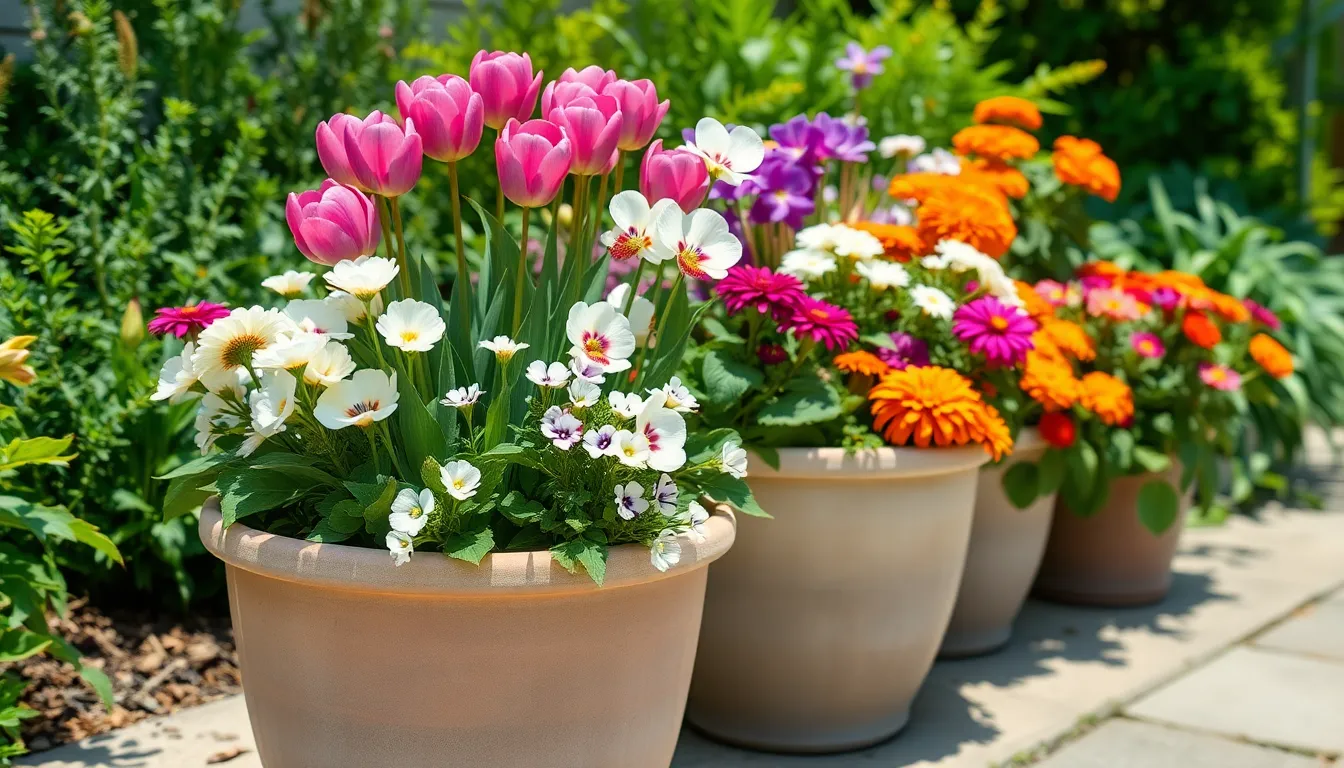
Creating stunning flower container arrangements transforms any space into a vibrant garden sanctuary. We’ll guide you through essential techniques to create arrangements that captivate and thrive.
Color Coordination and Seasonal Blooms
Select flowers that bloom during the same season for harmonious displays that naturally complement each other. Combining seasonal flowers with foliage such as caladiums, ivy, and ferns creates continuous color throughout the growing period. We recommend matching your color schemes to your outdoor decor for cohesive visual appeal.
Neutral-toned containers highlight vibrant blooms while maintaining excellent visual balance in your garden space. Consider these seasonal color combinations:
| Season | Recommended Colors | Example Combinations |
|---|---|---|
| Spring | Soft pastels | Pink tulips with white pansies |
| Summer | Bright yellows and purples | Marigolds with petunias |
| Fall | Warm oranges and reds | Mums with ornamental kale |
| Winter | Deep greens and whites | Evergreen with white cyclamen |
Group similar plants or repeat elements across several containers to create rhythm and cohesion in your garden arrangement.
Height and Texture Combinations
Incorporate plants of varying heights to create ever-changing visual interest in your container arrangements. Tall plants like agave or spiky grasses add essential structure to your design, while trailing plants and ground covers beautifully fill the lower areas.
Mix plants with different leaf shapes and textures for maximum visual impact. Broad-leafed hostas paired with fine-textured grasses create stunning contrasts that draw the eye. We suggest using this three-tier approach:
- Thriller plants (tall, dramatic specimens for the center)
- Filler plants (medium-height blooms that fill space)
- Spiller plants (trailing varieties that cascade over edges)
Enhance texture with decorative elements by adding pebbles or decorative stones inside and around containers. These materials reflect the surrounding industry and provide additional visual depth to your arrangements.
Low-Maintenance Flowering Options
Choose drought-tolerant plants like succulents, echeverias, and sedums for easy-care container gardens that thrive with minimal attention. These resilient options provide diverse tones, shapes, and textures while requiring significantly less water than traditional flowering plants.
Succulent arrangements work particularly well in hot, dry climates and shallow bowls where other plants might struggle. We’ve found these varieties especially rewarding for busy gardeners:
- Echeveria varieties for rosette formations and subtle color changes
- Sedum types for cascading growth and seasonal interest
- String of pearls for unique trailing texture
- Hens and chicks for rapid multiplication and ground coverage
Select perennial flowers or hardy annuals that require minimal attention between waterings for the ultimate low-maintenance approach. These choices ensure your container gardens remain beautiful throughout the season without demanding constant care.
Grow Fresh Vegetables in Limited Space
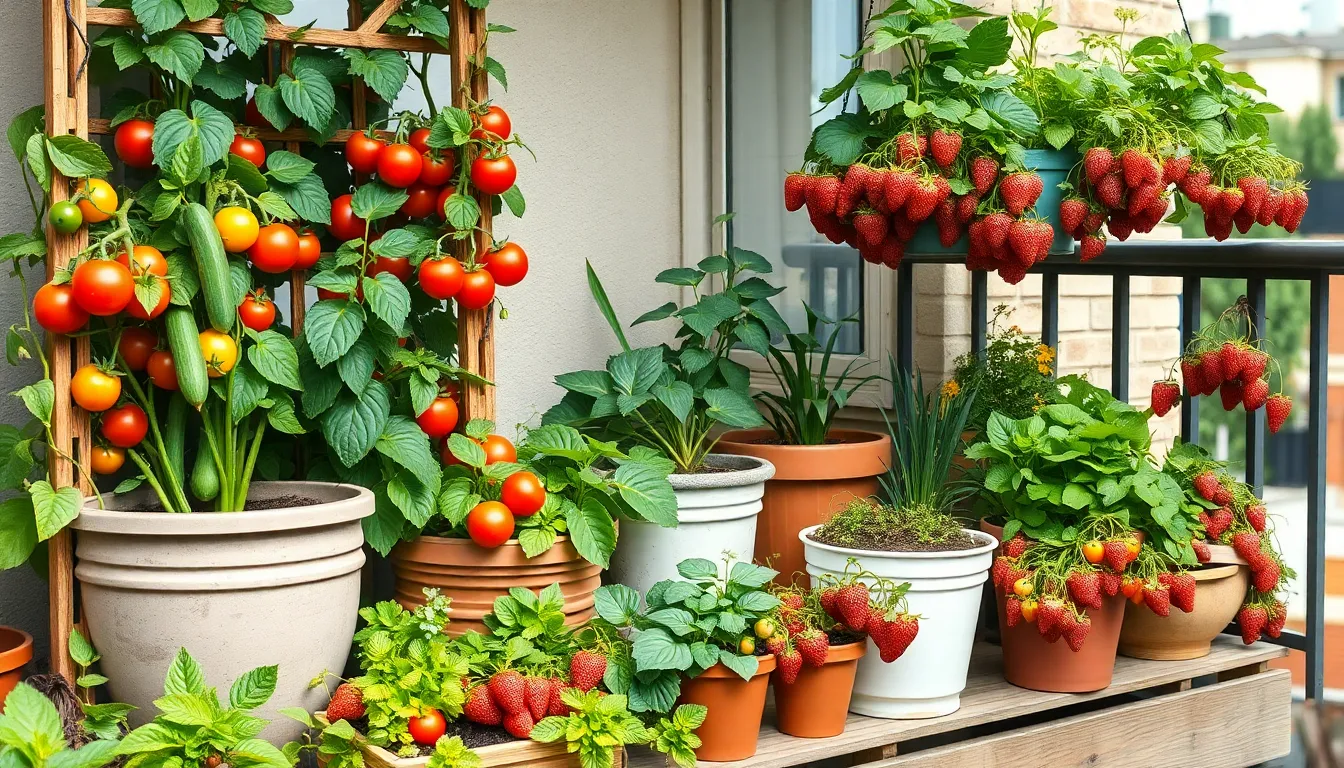
Container gardening transforms tiny patios, balconies, and windowsills into productive vegetable gardens. We’ll show you how to maximize your harvest through smart container selection, vertical techniques, and strategic planting methods.
Best Vegetables for Container Growing
Leafy greens excel in shallow containers and provide quick returns on your investment. Lettuce, spinach, arugula, kale, and Swiss chard thrive in 2-gallon containers or larger, making them perfect for beginners. We recommend starting with these varieties since they mature quickly and can be harvested continuously.
Quick-growing crops like radishes and green onions require minimal space and time to maturity. Garlic and herbs such as basil and parsley flourish in small pots, giving you fresh seasonings within weeks. These compact vegetables work perfectly for windowsill gardens or small balcony spaces.
Heat-loving vegetables need larger containers but offer substantial harvests throughout the growing season. Tomatoes, peppers, and eggplants require 5-gallon containers or more to develop strong root systems. We suggest choosing determinate tomato varieties for containers since they stay more compact than indeterminate types.
Climbing vegetables maximize vertical space while producing impressive yields. Cucumbers, green beans, and peas can be trained upward on trellises or stakes. These varieties work exceptionally well when you have limited ground space but adequate vertical room.
Root vegetables have exact depth requirements that determine container selection. Onions need at least 6 inches deep for green onions and 12 inches for bulbing varieties. Okra performs best in medium containers of 5 gallons or larger, providing continuous harvests in warm weather.
Vertical Growing Techniques
Trellises and support structures turn climbing vegetables into space-saving vertical gardens. We use cages, stakes, or wire frameworks to support cucumbers, peas, and pole beans as they grow upward. These structures can be easily moved with containers and adjusted as plants develop.
Hanging baskets create additional growing space without consuming ground area. Strawberries, cherry tomatoes, and trailing herbs work beautifully in suspended containers. We position hanging gardens to receive adequate sunlight while ensuring easy access for watering and harvesting.
Wall planters transform vertical surfaces into productive growing areas. Herbs, compact vegetables, and leafy greens thrive in wall-mounted container systems. These installations work particularly well on balcony railings or fence panels where horizontal space is limited.
DIY vertical systems offer budget-friendly alternatives to commercial tower gardens. Stacked pots, repurposed pallets, or tiered shelving create multi-level growing opportunities. We’ve found that these homemade answers often outperform expensive commercial systems while providing greater customization options.
Succession Planting Methods
Continuous harvesting ensures fresh vegetables throughout the growing season rather than overwhelming abundance at once. After harvesting spring crops like radishes or spinach, we replant the same containers with warm-season vegetables such as tomatoes, peppers, or beans. This method maximizes container productivity and extends harvest periods.
Interplanting strategies combine quick-maturing crops with slower-growing vegetables in the same container. Radishes and lettuce mature quickly around slower okra or eggplant, optimizing space and yield. We plant fast growers on container edges where they can be harvested without disturbing main crops.
Cut and come again harvesting extends productivity from leafy greens and herbs significantly. Instead of pulling entire plants, we harvest outer leaves while allowing centers to continue growing. This technique provides weeks of additional harvests from single plantings while maintaining plant health.
Seasonal rotation enables year-round vegetable production in containers. Cool-season crops like lettuce and spinach grow during fall and winter, while warm-season vegetables like tomatoes and peppers thrive in summer heat. We plan rotations based on local climate patterns to ensure continuous harvests regardless of season.
Establish Eye-Catching Succulent Displays
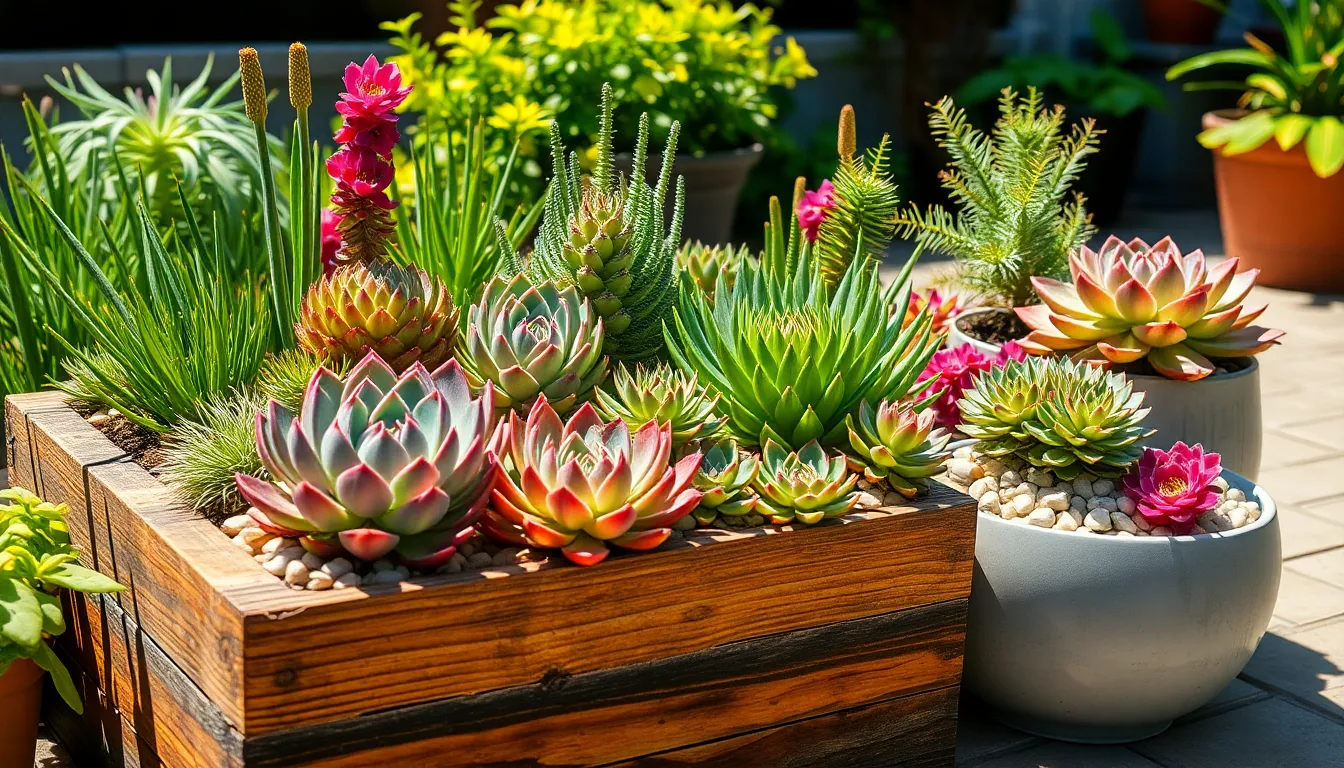
Building on our container gardening foundation, we’ll explore how succulents can transform any space into a stunning display with minimal maintenance requirements.
Drought-Tolerant Arrangement Ideas
Mixed succulent combinations create striking centerpieces by highlighting unique leaf shapes and forms in a single container. We recommend pairing echeverias with sedums in shallow bowls to showcase their contrasting textures and colors. These arrangements work perfectly for hot, dry climates where traditional flowers might struggle.
Living sculptures emerge when we position a potted blue agave as a focal point surrounded by decorative pebbles. The stones reflect larger rocks around the base, creating visual cohesion throughout your garden space. This technique transforms ordinary succulent plantings into artistic statements.
Outdoor table centerpieces using drought tolerant plants provide beautiful, low maintenance options for entertaining spaces. We suggest combining different succulent varieties in weatherproof containers that can withstand temperature fluctuations while maintaining their visual appeal.
Creative Container Combinations
Mix and match approaches combine rustic, vintage containers with new pots or elegant planters to create visually appealing contrasts. We’ve found that pairing weathered wooden boxes with sleek ceramic vessels adds depth and character to succulent displays.
Repetition and harmony techniques use similar plants in different containers to create rhythm throughout your garden space. Placing identical succulent varieties in varying sized pots establishes visual flow while maintaining design consistency.
Texture combinations emerge when we pair smooth ceramic containers with rough stone vessels, each housing complementary succulent varieties. These contrasts enhance the natural beauty of both the plants and their containers.
Indoor and Outdoor Placement Options
Hanging basket displays suspend colorful succulents from balconies or patios to add vertical interest and vibrant focal points. We recommend using trailing varieties like string of pearls or burro’s tail for cascading effects.
Window box installations filled with compact succulents enhance your home’s exterior while requiring minimal watering. These arrangements create year round visual interest without the maintenance demands of traditional flowering plants.
Indoor placement strategies bring succulent containers inside to add greenery to living spaces, especially during harsh weather conditions. We position these arrangements near bright windows where they’ll receive adequate light while serving as natural air purifiers.
Build Vertical Container Garden Systems
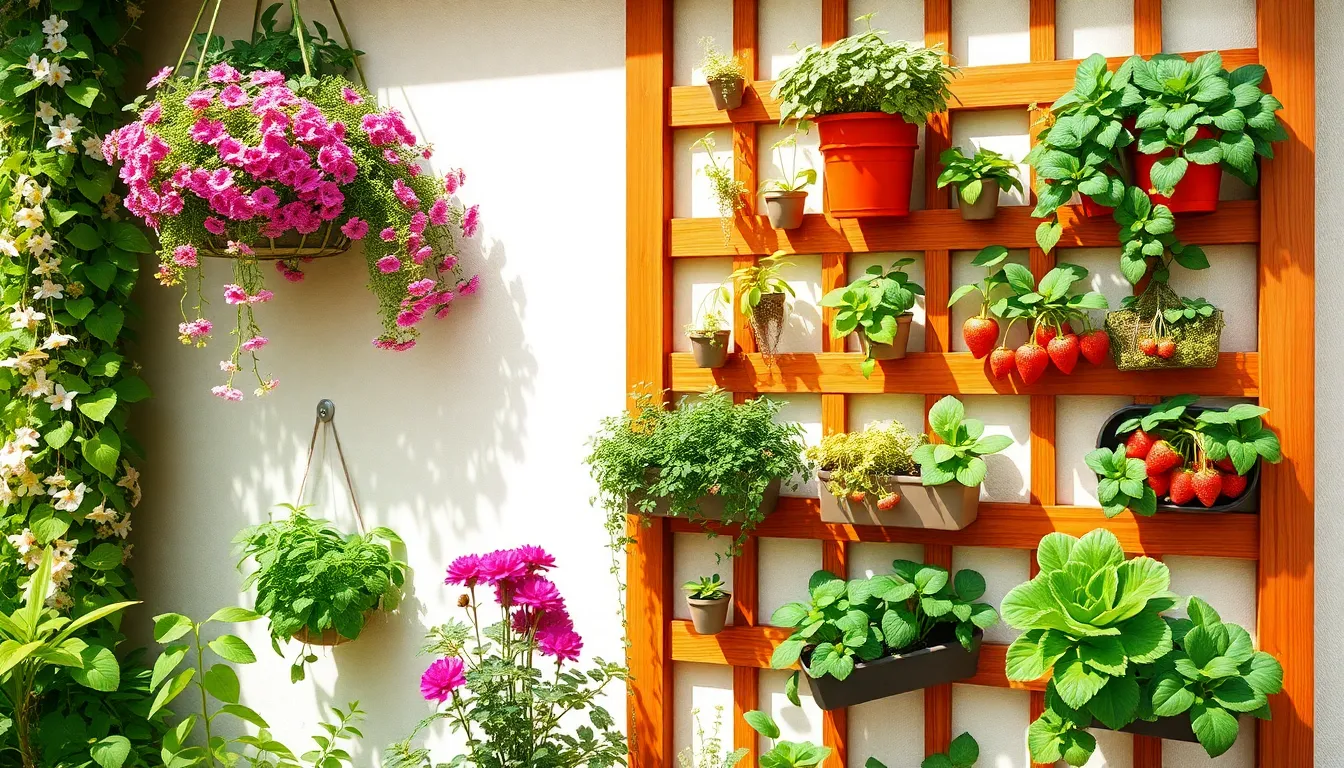
Vertical container gardens transform ordinary walls and small spaces into thriving green sanctuaries. These innovative systems allow us to grow more plants in less space while creating stunning visual displays.
Wall-Mounted Planting Answers
Trellis systems create beautiful climbing displays for plants like ivy and clematis. We recommend installing sturdy wooden or metal trellises against walls to support heavier vines as they mature. These structures provide excellent support for vegetables like peas and beans too.
Hanging baskets add instant color and movement to vertical spaces. Fill them with trailing flowers like petunias or practical herbs such as oregano and thyme. Position baskets at varying heights to create depth and visual interest throughout your garden area.
Magnetic planters offer incredible versatility for metal surfaces like refrigerators or outdoor metal fencing. These lightweight containers work perfectly for small herbs and succulents. Simply attach them wherever you need a splash of greenery without drilling holes or permanent installation.
Wall-mounted pocket planters maximize growing space in compact areas. These fabric or plastic systems hold multiple plants in individual pockets along a vertical surface. They’re ideal for growing lettuce, strawberries, and small flowering plants while keeping everything organized and accessible.
Tiered Container Arrangements
Tiered plant stands create stunning multi-level displays that showcase different plant varieties. Use wooden or metal stands with 3-4 levels to elevate smaller plants while leaving space for larger containers below. This arrangement allows every plant to receive adequate sunlight while creating an impressive garden focal point.
Stacked pots of varying sizes add architectural interest to container gardens. Start with a large base pot and gradually decrease sizes as you stack upward. This technique works exceptionally well for growing herbs, with larger plants like rosemary at the base and smaller varieties like chives on top.
Bricks and blocks provide affordable height answers for container arrangements. Place these materials behind larger containers to raise them to eye level and create natural tiers. This method helps hide unsightly features like downspouts while maximizing your garden’s visual impact.
Space-Maximizing Techniques
Layering combines vertical and horizontal growing methods to use every available inch. Place tall plants in back containers and shorter varieties in front, creating depth while ensuring all plants receive proper light exposure. This technique works particularly well for mixed vegetable and flower arrangements.
Corner utilization transforms forgotten spaces into productive growing areas. Large containers fit perfectly in corners, maximizing square footage while hiding unattractive architectural features. These spots often provide natural wind protection for delicate plants while creating cozy garden nooks.
Mixed plant combinations optimize container space by pairing plants with different growth habits. Combine upright growers like tomatoes with trailing varieties like nasturtiums in the same container. This approach creates visually appealing arrangements while maximizing harvest potential in limited space.
Incorporate Seasonal Container Themes
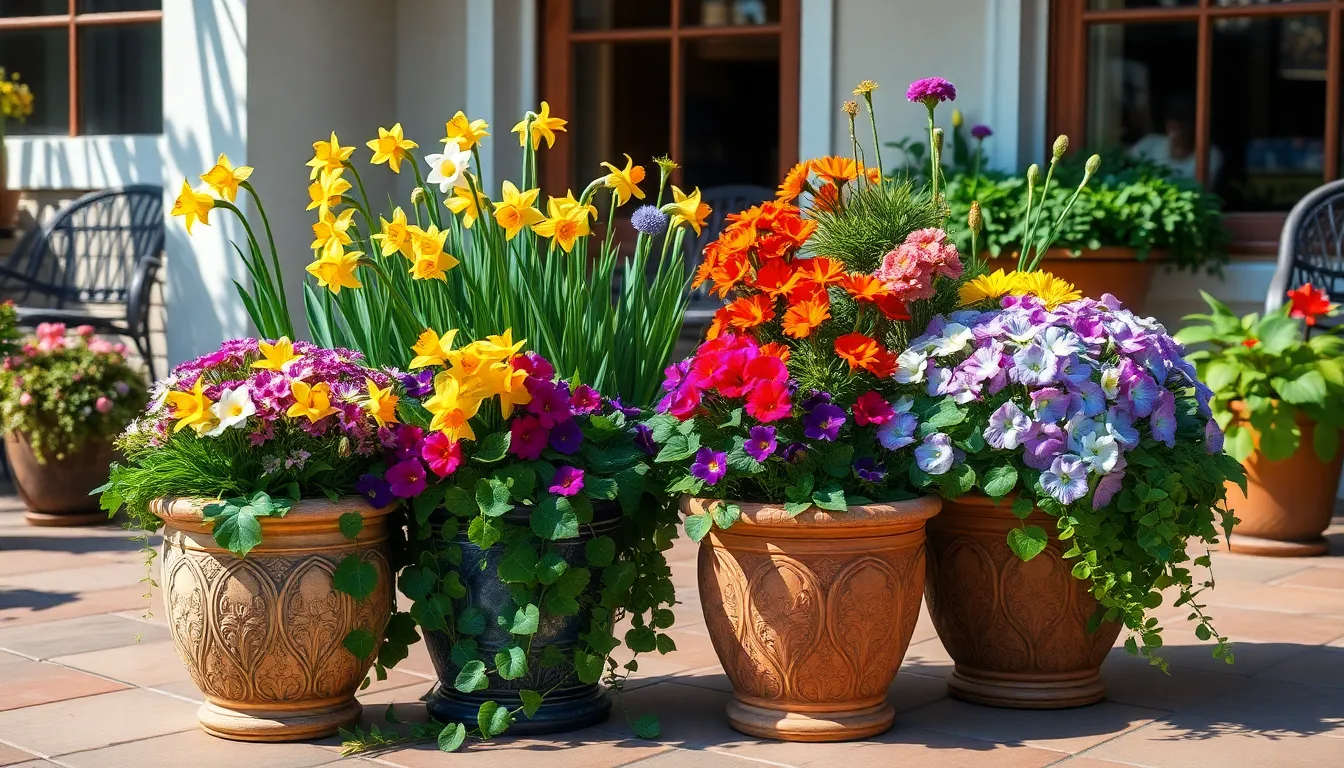
Seasonal container themes offer endless possibilities to refresh your garden displays throughout the year. We’ll explore how different plant combinations can transform your containers to reflect nature’s changing moods.
Spring Awakening Displays
Colorful blooms create the perfect foundation for spring container gardens. We combine daffodils with bold violas and calibrachoa to achieve vibrant displays that capture spring’s energetic spirit. These fragrant flowers work together beautifully while providing weeks of continuous color.
Textural interest elevates basic spring arrangements into sophisticated displays. We pair emerging spring flowers with evergreen plants like ivy to create lush, layered looks that add depth and visual complexity. The contrast between fresh blooms and established foliage creates stunning focal points for patios and entryways.
Early season planning ensures your containers transition smoothly from winter dormancy. We plant spring bulbs in fall, then add complementary annuals as temperatures warm to create seamless seasonal displays that evolve naturally.
Summer Abundance Arrangements
Unstructured looks capture summer’s wild, carefree energy perfectly. We use loose and airy plants like cosmos, achillea, and verbena bonariensis to create natural, whimsical appearances that mimic cottage garden styles. These combinations thrive in summer heat while requiring minimal maintenance.
Trailing petunias provide dramatic visual impact throughout summer months. We plant ‘Tidal Wave Red’ petunias for spectacular spilling effects in full sun locations, creating cascading waterfalls of color that draw attention from across the garden.
Fragrant mixes transform containers into sensory experiences during summer evenings. We combine lavender with summer herbs like thyme and rosemary to create aromatic combinations that attract beneficial pollinators while providing culinary ingredients for outdoor entertaining.
Heat tolerance becomes crucial for successful summer container gardens. We select drought-resistant varieties that maintain their beauty even during scorching temperatures, ensuring our displays remain vibrant throughout the hottest months.
Fall and Winter Interest Ideas
Warm tones welcome guests with autumn’s signature colors. We use orange pansies, violas, and Panolas to create inviting autumnal displays that celebrate harvest season’s rich palette. These hardy flowers continue blooming even as temperatures drop.
Evergreen keepers provide year-round structure for seasonal container gardens. We incorporate evergreen plants as permanent “keepers” that maintain visual interest throughout winter, then pair them with seasonal annuals that change with each season’s arrival.
Winter greenery extends container garden appeal into the coldest months. We add wintergreen plants and decorative elements like pinecones to create festive winter displays that brighten dreary winter landscapes. These arrangements provide much-needed color when most plants enter dormancy.
Seasonal transitions keep containers looking fresh year-round. We plan ahead by selecting plants that either persist through multiple seasons or can be easily replaced as weather conditions change, ensuring our displays never look tired or neglected.
Maintain Healthy Container Gardens Year-Round
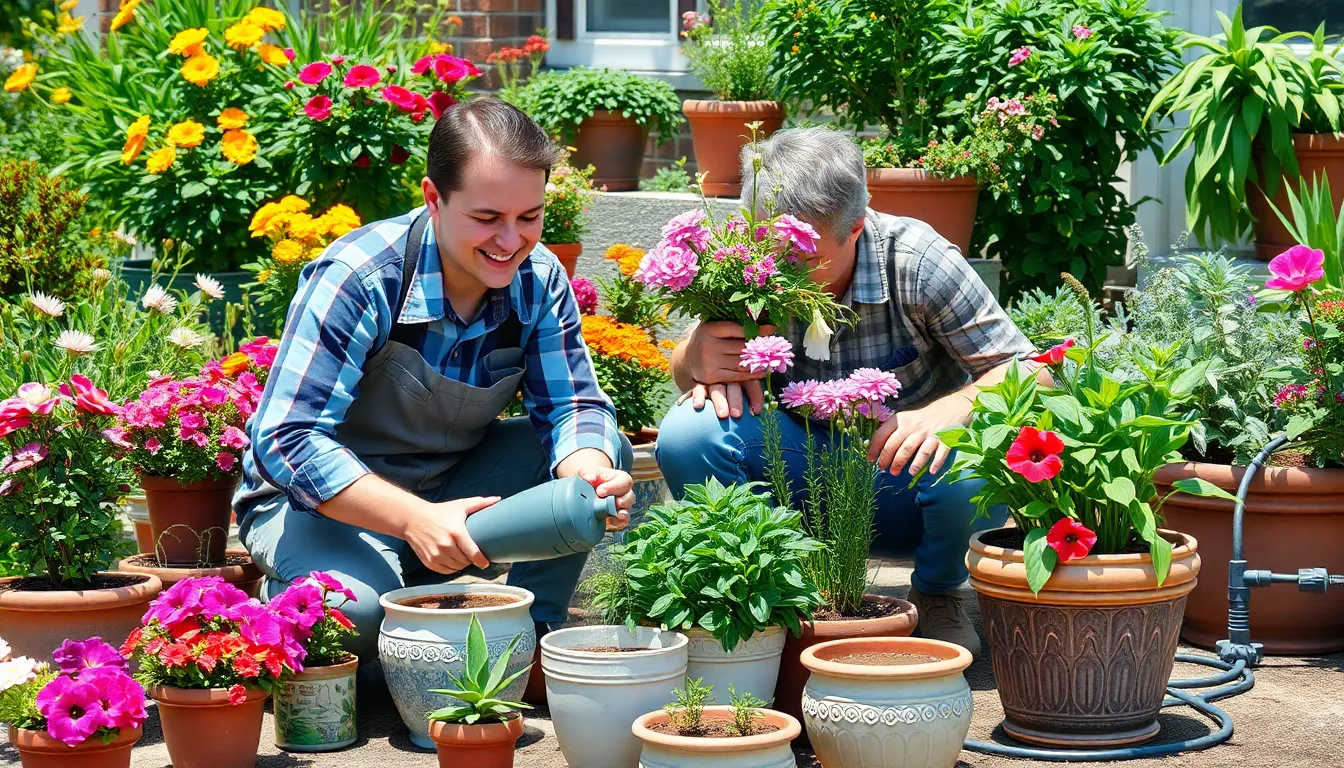
Successful container gardening requires consistent care and attention throughout all seasons. We’ll guide you through essential maintenance practices that keep your plants thriving regardless of weather conditions.
Watering and Fertilizing Schedules
Regular watering becomes critical during hot weather when container plants dry out faster than ground plantings. We check soil moisture by inserting our finger 1-2 inches deep into the potting mix. When the soil feels dry at this depth, it’s time to water thoroughly until water drains from the bottom holes.
Drip irrigation systems provide consistent moisture delivery, especially when we’re away or managing busy schedules. These automated systems prevent the stress of irregular watering and maintain optimal soil moisture levels. Container plants typically need daily watering during summer months and every few days during cooler periods.
Frequent watering leaches nutrients from container soil, making regular fertilization necessary for healthy plant growth. We apply small doses of balanced fertilizer weekly rather than large amounts monthly. This approach prevents nutrient burn while maintaining steady plant nutrition throughout the growing season.
Pest and Disease Prevention
Regular plant inspections help us catch pest problems before they become serious infestations. We examine leaves, stems, and soil surface weekly for signs of aphids, whiteflies, or other common container garden pests. Early detection allows for easier treatment and prevents damage to our plants.
Clean pruning tools prevent the spread of diseases between plants in our container gardens. We wipe cutting blades with rubbing alcohol between plants and replace any damaged or dirty tools. This simple practice stops bacterial and fungal infections from moving through our collection.
Biological controls minimize chemical use while effectively managing pest populations. We introduce beneficial insects like ladybugs for aphid control and apply neem oil for broader pest management. These natural methods protect our plants without harming beneficial garden visitors.
Seasonal Care Adjustments
Spring care focuses on planting new growth, pruning existing plants, and starting our fertilization schedule. We remove winter protection, trim dead or damaged branches, and begin weekly feeding as temperatures warm. Fresh potting mix additions help established containers start the growing season strong.
Summer maintenance requires increased watering and fertilizing due to higher temperatures and rapid plant growth. We may need to water containers twice daily during heat waves and increase fertilizer frequency to support vigorous growth. Shade cloth helps protect sensitive plants during extreme heat.
Fall preparation involves reducing watering and fertilizing as temperatures cool and plant growth slows. We gradually decrease water frequency and stop fertilizing most plants by late September. Deadheading spent flowers encourages final blooms while we prepare for dormancy.
Winter protection shields containers from frost damage and requires minimal watering unless plants need ongoing moisture. We wrap tender containers in bubble wrap, move pots to protected areas, and water only when soil becomes completely dry. Evergreen plants may need occasional winter watering during warm spells.
Conclusion
Container gardening opens up endless possibilities for transforming any space into a thriving green oasis. Whether you’re working with a tiny balcony or a spacious patio these versatile growing answers adapt to your unique situation and style preferences.
We’ve shown you how simple it can be to start your own container garden journey. From selecting the perfect containers to choosing plants that’ll flourish in your exact conditions every step builds toward creating something beautiful and functional.
The best part? You can start small and expand as your confidence grows. Pick one idea that excites you most and begin today. Your future self will thank you for taking that first step toward a more vibrant living space.
Frequently Asked Questions
What is container gardening and who is it suitable for?
Container gardening is a flexible gardening method where plants are grown in pots, planters, or other containers instead of directly in the ground. It’s perfect for people with limited space like apartment dwellers, renters, or those with small patios. This approach works for anyone regardless of gardening experience and allows you to grow flowers, herbs, vegetables, and even small trees in moveable containers.
What size containers do I need for different plants?
Most vegetables and herbs require containers at least 12 inches deep, but requirements vary by plant type. Leafy greens can thrive in shallower containers (6-8 inches), while root vegetables like carrots need deeper pots (12-18 inches). Tomatoes and larger plants require containers 18-24 inches deep. Always ensure your containers have proper drainage holes to prevent root rot.
What materials work best for container gardening?
Popular container materials include ceramic (attractive but heavy), plastic (lightweight and affordable), metal (durable but may heat up), and wood (natural look but requires maintenance). Budget-friendly alternatives include repurposed household items, thrift store finds, and DIY concrete containers. Choose materials based on your climate, budget, and aesthetic preferences while ensuring proper drainage.
Which herbs are best for container growing?
Essential culinary herbs for containers include basil, mint, rosemary, chives, parsley, and thyme. These herbs adapt well to container life and provide fresh ingredients year-round. Group herbs with similar water requirements together for easier maintenance. Basil pairs well with tomatoes, while Mediterranean herbs like rosemary and thyme prefer drier conditions than moisture-loving mint and parsley.
What vegetables grow well in containers?
Best container vegetables include leafy greens (lettuce, spinach), quick-growing crops (radishes, green onions), heat-loving plants (peppers, cherry tomatoes), and climbing varieties (beans, peas). Use trellises for vertical growing, hanging baskets for trailing plants, and practice succession planting for continuous harvests. Choose compact or dwarf varieties specifically bred for container growing.
How do I create attractive flower arrangements in containers?
Focus on color coordination by selecting seasonal blooms and complementary foliage. Use the “thriller, filler, spiller” approach with tall focal plants, medium-height fillers, and trailing spillers. Choose drought-tolerant options like succulents for low maintenance, or hardy annuals for continuous blooms. Vary heights and textures while maintaining a cohesive color scheme for visual impact.
What are the benefits of vertical container gardening?
Vertical gardening maximizes growing space by utilizing walls and vertical surfaces. Use wall-mounted planters, hanging baskets, tiered arrangements, and trellis systems to create multi-level displays. This approach is perfect for small spaces, adds visual interest, and can increase your growing capacity significantly. It also makes harvesting and maintenance easier at eye level.
How do I maintain container gardens throughout the seasons?
Container plants need more frequent watering than ground plants, especially in summer heat. Use drip irrigation for consistent moisture and fertilize regularly since nutrients wash out faster. Inspect plants weekly for pests and diseases. Adjust care seasonally: increase watering in summer, protect from frost in winter, and refresh soil annually for optimal plant health.
Can I grow container gardens year-round?
Yes, with proper planning and seasonal adjustments. Use cold-hardy plants for winter, move containers to protected areas during extreme weather, and consider indoor growing for herbs. Plan seasonal rotations with spring bulbs, summer annuals, autumn displays, and evergreen winter arrangements. This keeps your container garden attractive and productive throughout the year.
What are some budget-friendly container gardening ideas?
Repurpose household items like old buckets, plastic containers, or wooden crates as planters. Shop at thrift stores for unique containers, or make DIY concrete planters. Start plants from seeds rather than buying established plants, and propagate herbs and succulents for free plants. Share seeds and cuttings with friends to expand your garden affordably.

